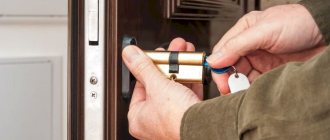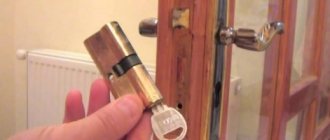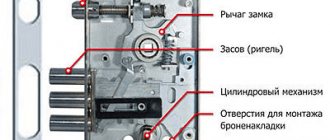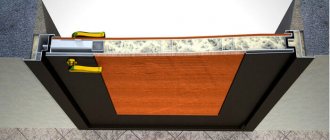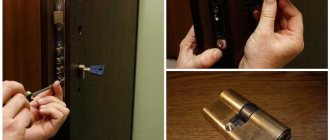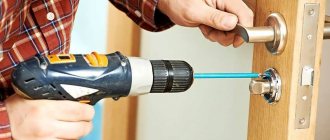The lock on the front door is an integral part of the apartment and any problems associated with it can cause inconvenience to its residents. Therefore, it is useful to know, if the front door lock is stuck, how to fix it. The most common difficulty is its jamming. However, most often this comes due to damage to the original door key.
On the other hand, problems with the lock may be associated with wear and tear on the structural parts, or more precisely, on its cylinder.
Causes of jamming
Lock repair may be required for various reasons. Damage can occur due to manufacturing defects, improper installation, misalignment of the door frame and a number of other factors. The most common mechanisms for entrance doors are cylinder and lever mortise locks; owners most often encounter the following malfunctions:
- The key does not come out. If it is stuck, do not try to pull it out using brute force. If you are inside or the door is open, you can try to lubricate the mechanism with a special lubricant, machine oil or other available materials. If the result is not achieved, you need to seek help from specialists to disassemble the core.
- The key is not inserted. This problem occurs due to damage to the key or a foreign object, such as a match, toothpick or paper clip, getting into the keyhole. You need to carefully inspect the well and try to remove the object and clean the hole. If the well itself is damaged, only a specialist can help.
- The lock jams when turning the key. The problem may arise due to debris getting into the keyhole, wear of the mechanism, or a key that has been ground down or is not processed well enough. Often this problem arises if the owner tries to use a “non-original” key made by a master.
- The tongue gets stuck. The problem arose due to the worn-out design of the lock; it will require replacement. Any mechanism requires periodic maintenance, and if it has not been carried out for many years, this can lead to breakdown.
- The tongue prevents the door from slamming. This situation occurs if the door leaf itself has shifted due to misalignment, and the tongue cannot fit into the corresponding hole. This problem often arises due to unprofessional installation of the door frame.
In all these situations, it is important not to panic and not try to pick the lock as quickly as possible by any means. Brute force can cause the key to simply break and a piece of debris to remain in the keyhole.
Why won't the key turn in the lock?
If the key does not turn in the lock, this is a sure sign of problems either with the secret mechanism or with the key. It is much easier to figure out the reasons for a key failure than a mechanism failure, if only because access to the inside of the lock is very limited. Before you begin to deal with lock malfunctions, you should determine the type of its secret mechanism. According to the type of secret, locks are divided into:
- levelers;
- cylinder;
- rack and pinion;
- magnetic.
Important! To determine the type of lock you don’t need to be an expert, just look at the key. Leveler keys are very different from cylinder lock keys.
Typical causes of lock faults
To open magnetic and rack locks you do not need to turn the key, so we will not consider them. As for lever and cylinder locking devices, this problem is more than relevant for them. If the key in the lever and cylinder lock does not turn, then there may be reasons for this.
- Key malfunction. Quite often, “flimsy” keys to cylinder locks break if they are used for other purposes: they are used to open bottles, used as a tool, or damaged by accident. It is highly not recommended to push a key whose tip has broken off or whose tooth has come off.
- Getting debris and dirt into the secret mechanism. The cylinder lock is sensitive to dirt because its mechanism is miniature. Grains of sand, falling between the pins, stop them and prevent them from working. Dirt gets into the lock in different ways: it can be pushed in by an intruder, it can penetrate into the secret along with a smeared key, or it can accumulate in the form of compressed lumps of dust over time.
- An attempt to break into the lock. If an attempt to break into a cylinder lock is unsuccessful, the mechanism may “refuse to accept the original key.” In this case, you can freely insert it into the keyhole, but you may not be able to turn it or pull it back out.
- Factory defect or incorrect installation. If you have just started using the lock, the inability to turn the key in it may be due to a defect that was caused by jamming of the mechanism. Or the locking device was not installed correctly.
- Wear. It is not surprising that a heavily worn lock will fail at one not-so-wonderful moment. But such a refusal is usually preceded by numerous cases of biting the key. In this case, the malfunction is entirely on the conscience of the owner, because it was he who allowed such wear and tear and did not take any measures.
Troubleshooting Methods
The type of repair depends on the design of the mechanism and the situation. There are several ways to fix minor problems:
- If the key breaks and a piece remains in the keyhole, you can try to remove it with tweezers or another device. Sometimes the method of tapping with short strokes helps: the fragment may appear from the gap, after which it will be easier to catch.
- If the key is stuck and cannot be knocked out of the cylinder lock hole, you can try to knock it out with improvised objects. However, such actions do not provide any guarantee; it is much safer to immediately call a specialist.
- If the front door lock periodically jams, it needs to be lubricated. To do this, use WD-40 liquid or machine oil. Any substance is applied with a lint-free cloth, but in no case should you use cotton swabs. Small lint can get into the mechanism, and this will only aggravate the problem.
Even if the lock jammed only once and you successfully managed to deal with the problem yourself, it still needs to be repaired or replaced. It may fail at the most inopportune moment, and then the problem cannot be fixed so easily.
How to disassemble the handle
Before you begin repairing the front door handle, you must remove its mechanism. However, if the handle breaks off, you won’t have to remove it, you just need to disassemble it.
Push design
To change the pressure model, you don’t need any special tools—all you need is one screwdriver. First you need to remove the decorative rosette, which can be screwed on from below with a small screw. The socket is removed through the handle. Then you need to unscrew all the other screws and screw ties that secure the mechanism. Now all that remains is to remove the handle and remove the mechanism.
If a structure is installed that is one large overlay (such products are often found on Chinese models), then it is removed differently. On the inside of the blade under the lining, you need to unscrew the fastening screws (there are 2 of them), after which the handle is completely removed along with the lining, sometimes from both sides at once.
Rotary model
If the rotary model breaks, then in addition to a screwdriver, to dismantle such a product you will need a thin metal object (an awl, a knitting needle, etc.). First you need to remove the decorative rosettes. A technological hole will open on the side. You need to insert the sharp end of a thin metal object into it and move the pin. After this, you can remove the handle and the entire broken mechanism.
How to repair a lock?
If you managed to open the door yourself, but the lock is stuck, you can try to repair it yourself. You can deal with minor problems with mortise, rim and padlocks yourself, although the final solution to the problem will only be a complete replacement.
How to fix a lock? There are several simple ways:
- For cylinder locks, the simplest method is to install a new cylinder (cylinder). The necessary spare parts can be purchased at the store along with a new set of keys. It is also recommended to change the cylinder if you or one of your family members has lost the key on the street.
- Cleaning the mechanism. If the problem is caused by debris and dirt getting inside, you can try removing the lock and completely disassembling it. Dust is removed with a hard brush, after which you need to apply a little lubricant to the lint-free material and treat all moving components of the mechanism.
- Adjusting the position of the tongue. If it is jammed, you need to remove, disassemble and lubricate the mechanism, and then put the tongue in the desired position.
- In interior door locks, you usually have to tighten a loose handle, change the latch or the entire cylinder.
More complex work options are a task for a professional armed with special tools.
The front door lock is jammed - is it due to the door?
The cause of jamming is often the door itself, in which a strong distortion has formed. In this case, due to this or sagging of the door, the locking plate will begin to touch the edges of the hole and will move with great difficulty.
To get rid of this, you will have to remove the door from its hinges and try to eliminate the deformation of the door leaf. If it subsides, you should place washers on the support pins of the canopies, slightly raising the door above the floor level.
How to replace the larva with your own hands?
Replacing a cylinder in a cylinder mechanism is not so difficult; this work can be done with your own hands. It includes the following steps:
- Remove the armor plate.
- Using a screwdriver, unscrew the fixing screw that holds the lock in the door.
- Remove the faulty cylinder.
- Install the new part and reassemble the components in reverse order.
This work does not take much time and allows you to restore the functionality of the structure. You can purchase a new cylinder at any specialized store; it is selected according to the size and configuration of the lock. To make the right choice, it is better to first remove the old larva and go to the store with it.
Lever locks are much more difficult to repair, so it is recommended to call a specialist. Unprofessional repairs will cause new serious damage, as a result of which the mechanism will have to be opened with master keys. To avoid unnecessary problems, it is safer to use professional help.
Problem 4: door handle tongue stuck
In door fittings made of durable steel materials, the square usually does not break, but during operation it can move in the direction of the tongue and press it. As a result, the movement of the tongue becomes difficult and it ceases to function properly. When this happens to a square, it becomes deformed and becomes too large. To solve the problem, you need to purchase a new square of the required size and replace it. This is done simply: you need to dismantle one of the handles, remove the fasteners, remove the hardware structure from the door leaf, replace the square, and install all the elements back. If the size of the square, on the contrary, is too large, you can shorten it and adjust it to the required parameters using a grinder. After completing these steps, the door handle tongue will begin to function properly again.
Lubricating the lock is a preventive measure
If the key regularly jams, but the mechanism continues to work, try lubricating it. This method will restore the normal movement of the mechanism components, and the key will turn more easily. For lubrication, a special liquid WD-40 is used - this is a universal material. The most reliable way is to dismantle the device, disassemble it and gradually lubricate each working component.
Lubrication is recommended for preventive purposes. Periodic maintenance of the mechanism extends the service life and eliminates sudden problems with opening.
How to open a door if the lock is jammed?
If the door does not open, you should not try to turn the key in the hole at any cost. This will lead to its breakage, the fragment will remain inside, which will aggravate the situation. Specific actions depend on the type of structure and the situation, but a few standard recommendations can be listed:
- Don't panic and don't use too much force to turn the key.
- Spray the keyhole with WD-40 spray or apply a small amount of machine oil with a syringe.
- Insert the key and gently rock it in the hole to distribute the lubricant.
- Try to open the door.
If the lock does not open after lubrication, you must call a specialist. You can only drill out the cylinder yourself, but this will require time, tools, and will also lead to damage to the door leaf and additional costs. A specialist will be able to use a special set of tools to open even a heavily damaged mechanism and avoid additional damage.
Types of locking structures
The sequence of actions that will help you get into the building varies depending on the structure of the mechanism. In an effort to make the shutter more reliable and minimize the possibility of hacking, manufacturers are changing the principle of operation. The most popular types of deadbolts are:
- cylinder;
- mortise;
- overhead;
- mounted
To find out how to open a jammed front door lock, let’s look at the features of their design.
Cylinder
The most common type of shutter. Many experts recommend installing just such mechanisms, as they are the most reliable and durable. The service life can be increased by installing a special titanium gasket on the body.
Photo from Gorodverey.ru
This device is quite simple to install. The secret of its strength is that it can only be opened with a standard (original) key.
The design is a set of cylinders located in the same plane. In a calm state, the crossbars are at the same level, a straightened spring presses on them from above, and there is a plug under each active element. A through groove for a flat key is cut into the shutter body.
When the door is opened, the unlocking element, thanks to its thread, clamps the springs of certain cylinders; when turned, the plugs are removed from their place.
Photo from Ebay.co.uk
This mechanism is quite easy to use, but how to get out of the situation if the lock cylinder of the front door is jammed?
To open the core, you need to remove the housing and disassemble it using a screwdriver. To do this, you need to insert the key and keep it in a static position. Then find the fasteners on the end of the mechanism and unscrew them.
When replacing pistons, it is important to take into account their exact size, because they may not fit and you will have to buy a new element.
Mortise
This type of design is reliably protected from burglary, but opening it in the event of a breakdown is problematic. If in the previous mechanism it was possible to replace one component, then this shutter device requires more careful preparation.
Photo from the website Instrument.ludus.rf
This happens due to the fact that the bolt does not have removable parts. To remove a defective copy, you will need more than one, several screwdrivers. The dismantling procedure is carried out in several stages:
- First, the handle is pulled out; first you need to loosen the clamping force by unscrewing the screws.
- Next, the decorative panel is removed.
- Then the bolts are unscrewed from the end part of the structure, which allows the entire body to be removed from the canvas.
When choosing a new mechanism, take the old one with you or measure its parameters; such preparations will eliminate the need to make adjustments and fill gaps in the sashes.
Overhead
How to open a jammed front door lock? The principle of removing such a structure is similar to dismantling a cylinder valve.
What is this mechanism? The name speaks for itself. The body seems to be placed on top of the canvas, and does not cut into the end. From the inside, such a device simply snaps into place. Therefore, you can often encounter the problem that the key turns inside the core while the bolt on that side remains motionless. Lubricating the elements or replacing the spring will help prevent final breakdown of the locking structure.
Photo from the website Instrument.ludus.rf
In both cases, the box must be removed. To do this, all fasteners are unscrewed. Then the cover is removed and the remaining fasteners are removed. Next, the functional elements are replaced. Due to the low cost, you can replace the entire case with all contents. A simple device quickly breaks down due to frequent loads.
Mounted
This type of mechanism is installed in garages or utility rooms. The entire body is brought out and is supported by a metal bow, which is threaded into a loop.
Such valves are easy to use and do not cause any complaints in terms of reliability. But since they often come into contact with an aggressive external environment, they often fail - due to rain, temperature changes and fresh air, the metal simply oxidizes and easily corrodes. The inner cylinder gradually stops functioning.
Photo from Osaexpress.ru
Typically, such mechanisms are dismantled by cutting the bow and then replacing it with a new device. But if the lock is still strong, then you need to take a thin aluminum plate and clean the main groove.
Should you try to repair the lock yourself?
Repairing the lock yourself always carries the risk of re-jamming and new malfunctions that can occur at the least opportune moment. In order not to be left outside the apartment without the opportunity to get inside, it is better not to take risks, but to immediately seek professional help. It is beneficial to contact the experts for the following reasons:
- Experience working with various types of structures. Employees regularly encounter breakdowns of lever, cylinder, and hinged structures and know how to handle them correctly.
- A complete set of tools and special master keys. The technician will carefully open the damaged mechanism so that you don’t have to repair the door for a long and expensive time.
- Quick response to requests. You don't have to wait long: our employee will arrive at the address in the shortest possible time.
- Quality and professionalism. We are able to cope with tasks of any complexity.
In addition to opening damaged lock mechanisms, we provide repairs and installations. Call a locksmith to install a new lock and rest assured that the structure will function for many years. A warranty card is provided, it confirms the excellent quality.
The lock is jammed or the key is stuck: causes and solution to the problem
A jammed lock or a stuck key is a common problem that always happens at the wrong time. But replacing door locks is not always necessary; you can fix the damage quickly and on your own. It is important to understand the cause of the breakdown and know how to fix it. Sticking of the crossbars and the key in the well occurs in some cases that you need to know.
The main reasons for lock failure
Any equipment informs the owner about a future breakdown with signals. By paying attention to them in a timely manner, you can avoid damage and replacement of the device. The first jamming requires contacting a specialist or disassembling and cleaning the parts yourself.
Important! If you disassemble the lock yourself, ensure that the structure is reassembled correctly after cleaning the parts.
Having mixed up the position of the plates in the lever lock, you will need to perform several dozen rearrangements of parts for proper assembly and operation of the structure.
If there is no response to warning signals, the lock, if it fails, will require calling technicians and opening the doors using a grinder and other devices. To prevent such situations, it is important to know the list of the main causes of breakdowns:
- The keyhole or cylinder is clogged with foreign objects or materials.
- Corrosion or a layer of dirt and dust has formed on the surfaces of parts, preventing normal operation.
- The key may have been damaged due to use other than its intended purpose. Some owners open bottles for them, opening oily food packaging.
- When you turn the handle on a closed door, it moves a little, making it difficult to open the lock. If there is little play, the crossbar will rub against the metal. The key may break or the lever lock may snap 1 turn.
- There may be defects in the production of duplicates of the key and the device itself.
- If the door is wooden, when the humidity level changes, it may swell and close poorly. In this case, the counter hole will shift, and the crossbars will fit tightly.
- If the hinges on a wooden or metal door shift (sag), the operation of the crossbars will be difficult. This may cause the key to become deformed or broken and the lock to jam.
- If a lock with a cylinder is used, breakdown is possible if the spring breaks and the pins fall out. In this case, they jam the key in the cylinder.
Knowing the possible causes of a breakdown, it is easier to understand what measures you need to take to correct the breakdown yourself or call a locksmith. Let's look at the main breakdowns and ways to solve the problem.
Important! If the lock breaks on a metal door with an installed internal decorative plate, you will need to call specialists from the company that installed the door. Only they will be able to remove the finish efficiently and free up access to the lock.
How to open a door if the lock is jammed?
It’s good if such a situation arose with the door open. In this case, the solution to the problem is simple. You need to remove the cylinder or lever lock. The key sticking out in the cylinder can be blown out with BD-40 liquid and gradually turning it from side to side, we try to turn it.
It doesn’t work, you need to move on to a more radical method. We clamp the key with pliers and try to loosen it and make a revolution. As a rule, constant spilling of liquid and loosening of the key is triggered and the key opens the lock.
If the door is closed and the lock is jammed, we perform the work in the same sequence. Constantly pouring liquid into the grooves of the key, we try to turn the key. We perform rotation in different directions with a small amplitude. If the reason is not a breakdown of the lock itself, you will be able to open the door. Broken lock or fallen pins - in this case, you will need to drill a hole in the cylinder and use a screwdriver, gradually moving the bolt to open the lock.
In the situation with lever locks, everything is more complicated. The VDeshki canister is equipped with a thin tube. After turning the key a little, insert the tube into the vacated gap and run the cleaning liquid into the lock. If the reason is thickened grease, dirt and dust that has gotten into the organic lock, treatment with VD-40 will deal with the blockage and the key will turn the bolt. The reason is that the lock is broken - you will have to call locksmiths and cut the locks with a grinder.
But if you managed to open the door, you can disassemble the lock and try to clean and lubricate it. To do this, remove the lock cover and put the parts in a certain order. We remove dirt and rust from the body. We clean each part from rust, oil and dirt, lubricate them with silicone grease and install them in place. All parts are installed in the same position as during disassembly.
After assembling the lock and checking its functionality, you can install it on the door. If there is a breakdown, the door locks will need to be replaced.
Important! For lubrication, you cannot use any vegetable oil, especially sunflower oil. Such work will lead to rapid damage to the lock. The oil will thicken and the lock can be opened with any key, if it is not jammed before. This method was used by burglars in the last century.
What to do if the key gets stuck?
The work should be performed in the same way as when the lock is jammed. A lot of patience will be required when vandals insert matches or other objects into the larva. To correct the situation, use pliers, carefully turning, to pull the key out of the hole. Using thin wires with curved edges, we pull out foreign objects from the larva.
If the cylinder is dirty or the lubricant has frozen, the keyhole is filled with VD, after a pause, we try to pull out the stuck key, gradually loosening it. It is important here not to break the key in the well. If this happens, you need to disassemble the lock or remove the cylinder and try to remove the fragment. Lever locks are simple in this regard. Having removed the cover, we release the plates and take out the fragment. If the key remains in the cylinder and does not come out after treatment with liquid, this will require replacing the cylinder.
More complex situations and if there are no skills in working with plumbing tools will require calling specialists.
What can I do to prevent the lock from jamming?
You can prevent breakdowns and prevent significant costs by paying attention to the first signs of breakdowns and minor jamming of the lock and door.
Never open a lock after turning the handle on a closed door.
As a rule, the hole for the latch is made with less play than that of the bolts (latches) of the lock. Therefore, the door moves away, the operation of the lock is hampered by additional friction against the metal of the counter hole in the door. In this case, the door is pressed until the latch clicks, then open the lock with the key.
Minor difficulties in removing or rotating the key require treating the lock with cleaning fluids or completely disassembling and lubricating the structure.
Distortions and sagging hinges cause difficulties in the normal operation of the door. It does not close completely, the lock begins to close with force. This kind of work is unacceptable. In this situation, calling specialists from the company that installed your door or adjusting the hidden hinges yourself will help.
It's easy to do. Using a hex key, we move the door in the place of rubbing, achieving normal operation. A well-installed door should stand in any position. Opening or closing moves are not allowed.
In conclusion, some conclusions.
It is very easy to allow a breakdown, but then it will require a lot of money and time to correct the situation. Lubricate the lock and cylinder, treat them with cleaning fluids, avoid distortions and difficulties in closing the lock - such simple work eliminates the possibility of a situation with protruding key fragments and a jammed lock.
Source website https://www.prostozamok.ru/
Let us know about it - rate it
We'll open it and fix it!
If the door does not open, the most reliable solution is to call specialists. The master arrives with a set of master keys, which can easily be used to open any locking mechanism. This will allow you to quickly solve the problem without cutting off the hinges and damaging the door leaf, which will save the owner from large additional costs.
We also offer professional lock replacement: call a specialist to immediately solve the problem with opening the door and install a new mechanism. We can install a structure of any type and complexity; the experience of our craftsmen allows us to cope with any task.
Extreme measures
If the lock installed in the iron door of a private house is jammed and it cannot be opened in any way, then you will have to remove the door leaf from the hinges. If the door block is made of metal, this will be much more difficult to do. Such designs have increased protection against burglary.
You will need a grinder; it is used to cut the crossbar hinges. Then, after removing the canvas, the broken locking mechanism is removed, new hinges are mounted and a new lock is installed.
Another option is to saw the tongue of the locking mechanism. But this method can only be used if there is sufficient clearance between the door frame and the leaf to complete this procedure.
If there is play in the door metal block, you can use a regular crowbar to open it. This tool is inserted into a suitable gap between the door leaf and the floor base so that the door can be lifted.
If none of the listed methods helped to open a jammed metal front door, and there is no desire to spoil the integrity of the door structure, then it is recommended to contact specialists.
